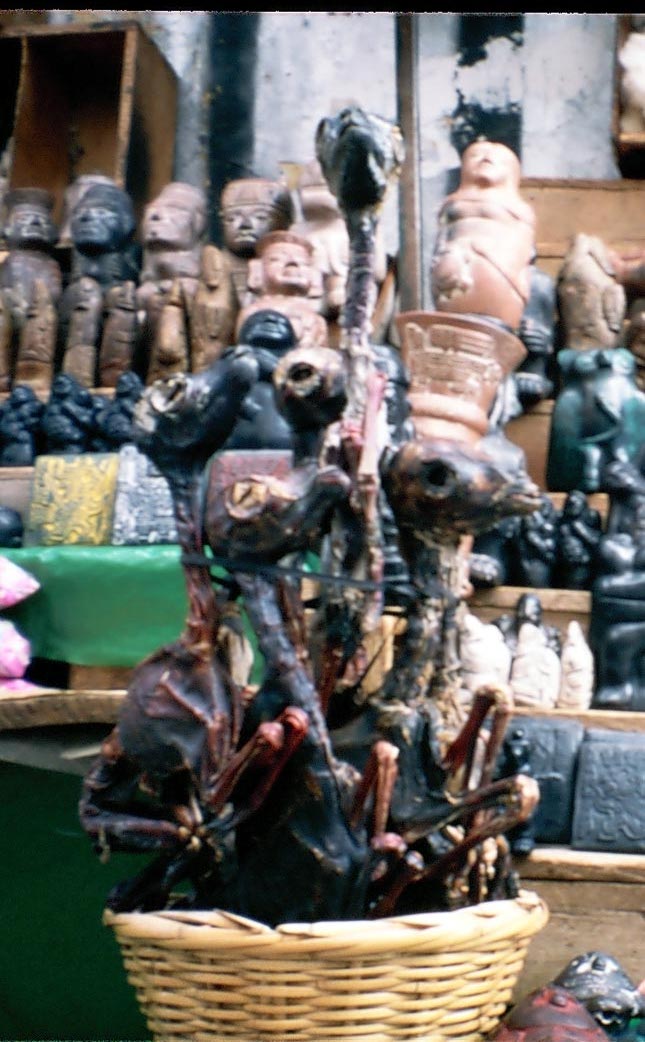
Travelogue Bolivia 2003
La Paz – Part 2
After a fantastic Lebanese lunch Carmen left the city and I went to the coca museum. On the museum’s homepage https://www.cocamuseum.com/ you find some information including a nice photo of El Tio and a mineworker on the first page. Here a summary of the most interesting points:

History: The use of coca leaves is very old; the Inkas did even operate brain tumours using coca for anaesthesia. After the Europeans came to the Americas the church did forbid the coca, but when they found out that the slaves working in the mines were much more efficient when chewing coca they allowed it immediately again. A single mine worker uses up to 380 grams of coca each week.
Usage: Following my newest information it is necessary to use sodium bicarbonate (bica, baking powder; other substances are used as well) as the cocaine can only be extracted if your salvia is alkaloid. So you put it in the mouth, chew a little bit to break the cells, let it suck a bit and then add the bica, that’s it. But don’t use only a few leaves, the people here always have a very thick cheek and when I saw the first such persion I thought that he had a tumour. Alternatively they sold coca sweets in the museum that you also put into your cheek. The taste is a little better but I didn’t feel a lot. If I was informed correctly the drinking of coca tea has no effect at all as it is missing the bica. But at least the leaves are said to be very healthy, many vitamins and other stuff. With the new information I am tempted to try it another time, but the taste is too ugly and if you take a lot you get an awful halitosis.
Effects: Chewing coca is more or less the same as a very slow and controlled consume of cocaine. Coca does not make you stronger but you can work longer without getting exhausted. Working at their maximum capacity the coca chewers do use significantly less oxygen as non chewers. Using coca the body tends to use the fat reserves of the body, the glucose level in the blood is much more stable. So if you want to loose some kilos or suffer from diabetes then get some coca …
Cocaine production: It needs some 320 kg of coca leaves to produce one kilo of coca paste. The past is made by a poor worker who has to trot for hours in a piscine where the leaves are mixed with kerosene and acids. The paste is more or less the same as crack, it is extremely toxic and addictive. Bolivia mainly exports the paste that afterwards gets cleaned in some improvised laboratories in Europe, the States or wherever, to finally get the cocaine. All this costs approximately 3000 dollars for a kilo.
Usage: Besides the worldwide drug abuse (about 50% in the USA) it is commonly used in medicine, for example there are some 146kg of legal cocaine produced in Germany each year, 500kg in the States. They told us that the anaesthetics used by dentists are normally based on cocaine or the synthetic and half as strong PROCAIN. And finally there is Coca-Cola. Between 1894 and 1914 it contained cocaine, but still today they use coca leaves for the taste.
But now for something completely different. On the witch craft market they sell dried llama fetuses. I imagine what would happen if I brought my mom one of these as a souvenir …

The next morning I wanted to leave for Copacabana and the Lago Titicaca. As I couldn’t sleep very well due to the altitude I got up quite early. In the lobby I met two friends who were also going to Copacabana and were just waiting to be picked up. I managed to get a ticket for the same bus and half an hour later we were on the way.
In the bus I changed my mined and wanted to go to Puno in Peru first, visiting Copacabana when coming back. But when we arrived in Copacabana they told us that the road to Peru was blocked by protesting campesinos (probably because of the plans to reduce coca production). So I am here now and rented a little sail boat to spend the afternoon. But after one hour in the self build boat I gave up because it was impossible to cruise against the wind. For those of you who don’t know sailing: that’s very important because otherwise you will never be able to return to the place you started from.

Tomorrow I will visit Isla del Sol, the place were the Inkas believed that the human race (or at least the Inkas) were created by god. I probably will spent a night there and then I have to leave Bolivia as my visa expires … I never imagined to spent a whole month in this country, incredible.
All the best from Copacabana, Bolivia
Volker